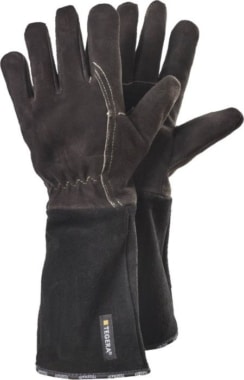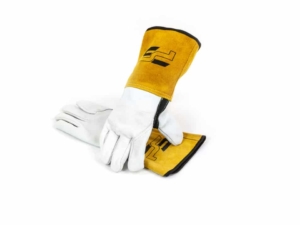Welding Gloves Uses: 3 Types of Welding Gloves
Welding gloves are an important part of the welding process, and there are a few different types that you can choose from. This article will discuss the three main types of welding gloves and explain what each one is used for, and also talk about some of the features that you should look for when shopping for welding gloves, providing you with a list of some of the best manufacturers and suppliers in the industry.
Key Points
What are welding gloves?
Welding gloves, also known as protective gloves or safety gloves, are an essential piece of equipment for anyone involved in the welding process. Welding gloves provide hand protection from high heat, sparks, and other hazards that can be generated during welding operations.
Depending on the type of welding being performed, a different type of welding glove may be needed. For instance, MIG welding gloves are different from TIG welding gloves, and stick welding gloves require a different type of leather than other welding processes.
The right welding glove can make all the difference in ensuring the welder's safety and comfort during the welding process. When purchasing welding gloves, it's important to consider the type of welding being performed, the material of the glove, and the specific hazards of the welding application.
Welding gloves are typically made of leather and are designed to offer high durability and protection from sparks. They may also feature Velcro straps for a secure fit and added protection. Proper welding gloves can make a huge difference in the outcome of the job, and they are a must-have for anyone planning to perform any welding job.
Why is it important to choose the right welding gloves?
When it comes to welding, gloves are an important part of the process. Not only do they protect your hands from the heat and sparks that are generated during welding, but they also help to prevent burns and other injuries.
As you may already know, welding can be a dangerous activity that involves high temperatures, sparks, and sharp objects, which can cause serious injuries if proper protection is not worn. The right welding gloves can provide a barrier against heat, cuts, and abrasions, ensuring that the welder's hands are protected from harm. Choosing the right gloves is essential for the welder's safety and comfort during the welding process, and it can also impact the quality of the work produced.
Welders need to be able to handle tools and materials with ease, and the right gloves can provide the necessary grip and dexterity. When it comes to welding, investing in the right gloves is a crucial decision that can make a significant difference in the outcome of the job and the safety of the worker.
What to consider before purchasing welding gloves
There are a few different types of welding gloves available on the market, so it is important to choose the right ones for your specific needs. When shopping for welding gloves, there are a few features that you should look for:
1. Material: Welding gloves are typically made of leather, but the type of leather can vary. Choose gloves made of high-quality leather that will protect against heat, sparks, and debris. Cowhide gloves are a durable and affordable choice, while pigskin gloves offer a more flexible and comfortable fit. Welding gloves may also have reinforcement in high-wear areas, such as the thumb and palm.
2. Size and fit: Welding gloves should fit snugly on the hand to ensure maximum protection and control.Consider the size of your hand and the type of welding you will be doing when selecting gloves.Keep in mind that gloves will break in over time and stretch a bit, so a snug fit at first is important.
3. Heat resistance: One of the most important factors in selecting welding gloves is heat resistance. Look for gloves that are rated to withstand the temperature of your welding process, usually measured in seconds. The higher the rating, the longer the gloves will withstand heat and protect your hands.
4. Dexterity: Welding gloves should allow for dexterity and flexibility while working. Some gloves come with a pre-curved design or a slightly bent shape to allow more natural hand movement. If you need to be able to pick up small items or operate tools while wearing gloves, consider gloves with added grip features.
5. Cuff length: The length of the cuff on welding gloves is an important consideration, as it will affect the amount of forearm protection provided. Longer cuffs protect the forearm from sparks and debris, but can sometimes interfere with movement. Shorter cuffs are more flexible but may not provide as much protection.
6. Overall comfort: Welding gloves should be comfortable to wear for your entire welding session. Look for gloves with a soft interior lining and adequate ventilation to prevent sweat buildup. Some gloves may also have features such as breathable mesh panels or padded liners for added comfort.
7. Durability: Welding gloves are typically exposed to high levels of wear and tear, so it's important to choose gloves that are durable and long-lasting. Check for reinforced areas, stitching quality, and overall construction to ensure your gloves can withstand the rigors of welding on a regular basis.
What are some other features that welders should look for in safety gloves?
A good fit: Welding gloves need to fit snugly but not be too tight. They should also allow you to move your fingers freely.
Good dexterity: Look for welding gloves that offer good dexterity so you can still grip small objects easily.
Protection: Make sure the welding gloves you choose offer good protection from heat, sparks, and burns.
Durability: Choose welding gloves that are made from durable materials such as leather or Kevlar.
Thickness: your protective gloves must be thicker and contain multiple layers.
Types of welding gloves
There are three main types of welding gloves: leather, cotton, and Kevlar. Each type of glove has its own advantages and disadvantages, so it is important to choose the right pair for your needs. Here is a closer look at each type of welding glove.
TIG Welding Gloves:
TIG welding involves an arc welding technique that employs a tungsten electrode which is not consumed, along with the workpiece, to generate the weld. TIG gloves are made from a variety of materials, but the most common type is leather. Leather gloves are durable and offer good protection from sparks and heat. However, they can be bulky and can make it difficult to grip small objects. TIG welding gloves usually have a lined interior for added comfort and protection.
The TIG gloves have been created with the ease of removal in mind, especially when there's excessive heat. It's important to note that gloves featuring Velcro straps can be quite challenging to take off, making it very inconvenient to discard them quickly in case of high temperatures.
MIG Welding Gloves:
MIG welding gloves are usually made from Kevlar or cotton. Kevlar gloves are lightweight and offer good dexterity, but they may not provide as much protection as leather gloves. Usually used for light-duty welding, these gloves are not recommended for use with TIG welding. Cotton gloves offer good protection from sparks and heat, but they are not as durable as leather or Kevlar gloves.
There are three main types of welding gloves: leather, cotton, and Kevlar. Each type of glove has its own advantages and disadvantages, so it is important to choose the right pair for your needs. Here is a closer look at each type of welding glove.

Stick Welding Gloves:
Stick welding gloves are made from a variety of materials, but the most common type is leather. They are usually used for welding in tight spaces or when welding for long periods of time. Stick welding gloves usually have a lined interior for added comfort and protection.
In conclusion, welding gloves are an important part of the welding process and there are a few different types that you can choose from. This article has discussed the three main types of welding gloves and explained what each one is used for. It has also talked about some of the features that you should look for when shopping for welding gloves.
What type of material is best for welding gloves? - are leather welding gloves your best option?
Leather tends to be the most suitable material for welding gloves. This is because leather provides excellent heat resistance and durability, protecting the hands from sparks, heat, and other hazards associated with welding. Other materials used for welding gloves include Kevlar, Nomex, and spandex, which provide extra protection against cuts and abrasions. However, they do not offer the same level of heat resistance as leather
Why Wait? Check Out Our Full Cut-Resistant Gloves Range Today By…
…clicking here, or by contacting a member of our highly-experienced team today on +44(0)121 544 5208 or by sending an email to sales@provincialsafety.co.uk. The entire Provincial Safety team look forward to hearing from you.



